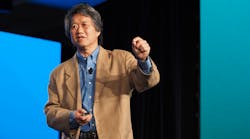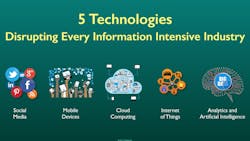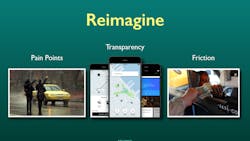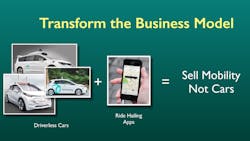DANA POINT, CA. The last decade has seen plenty of examples of almost shocking business disruption. Futurist Chunka Mui coached fleet executives on how to rethink their businesses and drive innovation so the next flip of the coin doesn't leave them behind, like others have been.
Before the turn of the millennium, Mui predicted how the Internet and software apps — just like groundbreaking inventions in history — could change commerce and everyday life in Unleashing the Killer App, which he co-authored. Speaking here at Telogis, A Verizon Company's Latitude business conference, he said established businesses don't have to lose out to or be suddenly outrun by startups.
Incumbents sitting on their laurels, though, just might guarantee they'll become obsolete.
That's the theme of his new book and a tone-setter at this conference: how to use technology and what to do to avoid getting jolted by disruption of some kind. While "disruption" is the buzz word often tossed around now, this is really just change you didn't expect, foresee or prepare for that can shake up entire industries — and maybe put you out of business.
The challenge, Mui said, is to "take advantage of the capabilities afforded by new technologies before your competitors do," but that's much easier said than done.
Things are not only changing very drastically in some instances, the rate of change is accelerating. The iPhone was introduced in 2007; 10 years later, the Pew Research Center estimates that more than three out of four Americans have smartphones. According to a New York Times report, it took just several years from Uber's introduction of its ride service in New York City and as of this July, the company outpaced traditional Yellow Cab rides there.
"Almost a third of companies that were on the Fortune 500 list 10 years ago are no longer there," Mui said. "And 10 years from now, probably a third of the companies that are on the list today won't be there."
Mui quoted the late science fiction writer William Gibson: "The future is already here — it's just not evenly distributed." He advised listeners to look around them now and "think about the future and how it impacts your customers, your companies, and your own professional career."
Here are five tips he laid out for companies to work at innovation, and maybe even launch the next big thing that changes everything.
1. Embrace the gap.
Mui said companies "are optimized" around their current products and services and work to develop incremental improvements to them. "But technology moves exponentially," he noted, and businesses like those in transportation, logistics and distribution may need to embrace that and think more radically.
Companies like Borders, Blockbuster, Yahoo and Kodak "all did great things" but were lapped, essentially, by disruptors, Mui noted.
Five technologies to focus on in terms of innovating current products and processes are social media, mobile devices, cloud computing, the Internet of Things, and Big Data/ artificial intelligence, he contended: "All information-intensive industries including yours will be affected in some dramatic way by these technologies over the near-term."
2. Think big.
"From a planning standpoint, you'll have to explore a whole range of strategic options. You have to be willing to say, 'How might somebody else take these technologies and disrupt my business? How do I start from a clean sheet of paper and reimagine my business using these capabilities?'" Mui said.
He used the example of the automotive industry, where the dominant players have been the leaders for quite some time. But autonomous vehicle experimentation and changing attitudes about vehicle ownership could change that.
Mui noted that on average, passenger cars are unused 95% of the time. With autonomous vehicles, the automobile industry may see a shift away from selling cars toward selling mobility, as in shared or app-ordered rides from self-driving cars.
Reading between the lines, there could be lots of money to be made, as Google and many other companies are now betting.
"Who manages this fleet of tens of thousands or hundreds of thousands of driverless cars? How do you service them? How do you track where they are? How do you get them to the right spot? Who cleans them?" Mui asked. "How does this transform distribution and logistics? How does it transform the nature of business all along the continuum, including your business?"
Those are the kinds of questions fleets and others need to be asking themselves as they think about how to apply today's technology to current business models, and possibly transform them forever.
3. Start small.
Mui noted that when it comes to innovation, businesses often have the problem of getting caught up with too many ideas — i.e., spreading themselves too thin.
"Think about a really small number of really big ideas," he said. He set up three categories for those ideas: government-mandated or other changes you need to make to stay in business; changes that will earn a higher return on investment based on how you now do business; and "option-creating investments" that build new capabilities for the future.
Rather than just trying to improve on and innovate their own businesses, Mui suggested that listeners consider what the competition is doing — and how that could change after their businesses have released an innovation.
"Competition is always moving," he contended.
4. Learn fast.
Mui also advised "to not fall in love with your idea, but break it down." Once your company has come up with what it believes is a great innovation, he said, test it and get data — don't base your actions on intuition, passion, hope and so on.
"The companies that innovate successfully are the ones that take a scientific approach to innovation," he added. To wit, Mui noted that Google kept its self-driving vehicle experimentation under wraps until the company had cars it'd tested for over 100,000 miles.
And while many organizations are getting in on autonomous vehicles now, last year, Mui noted that Google logged 30 times more miles with its driverless cars than all its competitors' combined did.
The moral of the story? "It's the fastest learner who wins," said Mui.
5. Cultivate "patient urgency."
"In innovation, you're always balancing between two tensions," Mui told the audience. "One is that if you don't get the market timing right, almost nothing else matters.
"The second tension, however, is that precise timing is a fool's error," he continued. "You can never get it right."
So the goal is to launch your innovation when the world's ready for it, but essentially, don't let the perfect be the enemy of the good, as the saying goes. Mui said companies need audacity to move forward with their ideas, tempered by the patience to wait for the right conditions when their ideas will thrive.
One example of this, he noted, was when Reed Hastings co-founded Netflix. Hastings believed the future would be in people streaming movies and other video content via the Internet, yet Netflix was built first on a successful mail-exchange DVD rental model.
When the time was right and Internet speeds were up to it, Netflix went live with streaming video — after having worked on that technology for 10 years.
"You have to sense the opportunity, work at it and be ready," Mui said. "You can't get the timing precisely, but as Louis Pasteur said, 'Chance favors the prepared mind.'"






